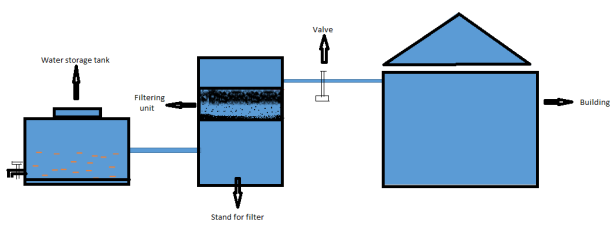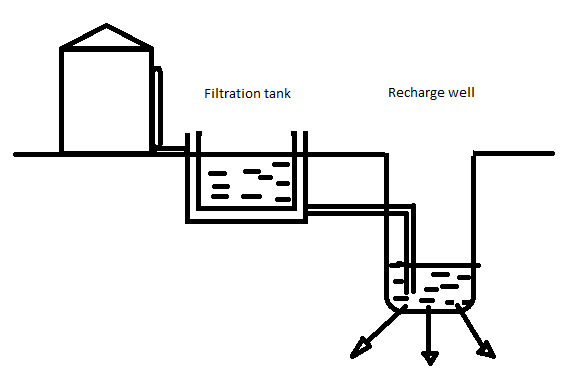Rainwater harvesting methods are the processes in which precipitation that falls on a site is diverted, captured, and stored for use on-site, as opposed to allowing it to run off, evaporate, or infiltrate into the soil. Let’s get to know it in the best way through the course of journey in the blog.
“Slanting silver ropes slammed into loose earth, plowing it up like gunfire”- When Arundhati Roy described the rain as beautifully like this, how many of us thought we are taking the boon of no cost from nature. It’s high time that we understood the worth of various rainwater harvesting methods in our lives.
Let’s start from scratch.
How rainwater harvesting methods are important?
This is a sad story of ground water. It all started with the over population. water supply agencies became unable to cope up demand from surface sources like dams, reservoirs, rivers etc. They resorted to ground water sources by digging tube-wells in order to augment the water supply. Indiscriminate exploitation of ground water resulted in lowering of water table rendering many bore-wells dry. To overcome this, we started to drill bore wells to greater depths. The exploitation of ground water in brutal unscientific methods by soft drinks, mineral water and similar industries further declined ground water table. The solution to all these problems is to replenish ground water bodies with water conservation like leveraging rain water by man made means.
That’s it. And we are here to know the hero of the story, Rain water to solve all these issues.
Let’s look at its components now.
Components of rainwater harvesting methods
Rainwater conservation is a must need element of every green building. Let’s see the components below.
1. Catchment area
The catchment area is the surface on which the rain water falls. This may be a roof top or open area around the building.
2. Coarse mesh / leaf screen
To prevent the entry of leaves and other debris in the system, the coarse mesh should be provided at the mouth of inflow pipe for flat roofs
3. Gutter
Gutter is required to be used for collecting rainwater from sloping roof and to divert it to downspout. These are the channels all around the edge of a sloping roof to collect and transport rain water to the storage tank.
4. Down spout or conduit
The rain water collected on the roof top is transported down to storage facility through down spouts / conduits. Conduits can be of any material like PVC, GI or cast iron.
5. First flushing device
A first flush system is incorporated in the rooftop to harvest rainwater by avoiding all the debris, dirt, and other contaminants especially bird dropping, etc. accumulated on the roof during the dry season. The first flushing device, dispose of the first spell of rainwater so that it does not enter the system.
6. Filter
The filter unit is basically a chamber filled with filtering media such as fiber, coarse sand and gravel layers to remove debris and dirt from water before it enters the storage tank.
7. Settlement tank
The settlement tank facilitates the settling down of suspended materials like silt and other floating impurities before the water recharge the aquifer.
8. Storage tank
Storage tanks are used when the water from the rain water harvesting is used directly for various purposes.
Okay. That’s done. Now we are getting into the important part which is how to make rainwater harvesting.
RAINWATER HARVESTING METHODS- DETAILED
1. Storing rain water for direct use

Fig. Storing rainwater for direct use
In place where the rains occur throughout the year, rain water can be stored in tanks However, at places where rains are for 2 to 3 months, huge volume of storage tanks would have to be provided. In such places, it will be more appropriate to use rain water to recharge ground water aquifers rather than to go for storage. If the strata is impermeable, then storing rain water in storage tanks for direct use is a better method. Similarly, if the ground water is saline/unfit for human consumption or ground water table is very deep, this is one of the best rain water harvesting methods that can be applied.
2. Recharging groundwater aquifers, from rooftop runoff

Fig. Recharging ground water aquifers from roof top run off
In this groundwater harvesting, rain water that is collected on the roof top of the building may be diverted by drain pipes to a filtration tank from which it flows into the recharge well. The recharge well should preferably be shallower than the water table. This method of rain water harvesting is preferable in the areas where the rainfall occurs only for a short period in a year and water table is at a shallow depth.
Alright. That’s it about second in the list of rainwater harvesting methods. How to increase groundwater level further?
3. Recharging groundwater aquifers with runoff from the ground area

Fig. Recharging ground water aquifers with runoff from ground areas
The rain water that is collected from the open areas may be diverted by drain pipes to a recharge dug well / bore well through filter tanks. The abandoned bore well/dug well can be used cost effectively for this purpose.
Now you have become a savvy in rain water harvesting methods. But this is not all. Even if you have completed all the procedures with at most care, precautions should be taken to ensure quality of water. Let’s see them.
1. Roof over which water falls, should be cleaned before rain fall.
2. The suitable type of first flushing device to be installed and initial 10 to 15 minutes of runoff should be diverted.
3. The water collected from roof top only, should be stored in storage tank for direct use.
4. The runoff from surface/ground should be preferably be used for recharging ground water aquifers after proper filtration.
5. The rain water collected from roof top should pass through suitable type of filter and only then it should be stored in storage tank / used for recharging ground water aquifers.
We are almost near of completion. its time to look at the results of your efforts.
Advantages of rain water harvesting methods are,
(a) Promotes adequacy of underground water
(b) Mitigates the effect of drought
(c) Reduces soil erosion as surface run-off is reduced
(d) Decreases load on storm water disposal system
(e) Reduces flood hazards
(f) Improves ground water quality / decreases salinity (by dilution)
(g) Prevents ingress of sea water in subsurface aquifers in coastal areas 6
(h) Saving rainwater improves ground water table, thus saving energy (to lift water)
(i) The cost of recharging subsurface aquifer is lower than surface reservoirs
(j) The subsurface aquifer also serves as storage and distribution system
(k) No land is wasted for storage purpose and no population displacement is involved
(l) Storing water underground is environment friendly
But all these doesn’t earn you a penny. Below are the points that illustrates how rain water harvesting methods can add to your pockets.
Energy savings
- Rainwater collector systems are typically designed to be gravity fed.
- Storage areas are typically lower elevation, so a pumping system is generally required for intended reuse.
- Since collected rainwater is generally used close to its capture, the energy needed to convey the water tends to be minimal.
- Compared to conveyance from other supplied sources of water rainwater harvesting methods would likely have lower energy costs.
- Systems are simple and tend to be robust. Monitoring and maintenance require additional effort. This includes maintenance of roofs used as collection areas, cleaning of gutters, maintenance of storage tanks and vaults, puumps and maintenance of water treatment systems
Water savings
- A reasonable goal for an aggressive rooftop collection for a custom building could be to reduce domestic water supply by 40 to 50% for that building; this would then allow the building to meet LEED goals for sewage reduction.
Well… limitations too are important to see if it’s worth trying.
Happy to see the cost savings? Then you should definitely check out A BUILDING AT ZERO COST!!
Disadvantages of rain water harvesting methods are,
- Unpredictable Rainfall
- Initial High Cost
- Regular Maintenance
- Certain Roof Types may Seep Chemicals or Animal Droppings
- Storage Limits
Now, it’s up to your decision on which of the above rainwater harvesting methods you want to adopt. But I would say this is an offer you can’t refuse.
Vincivil FAQ CORNER
What is the main purpose of rainwater harvesting methods?
The main aim of rainwater harvesting methods is to use locally available rainwater to meet water needs during the year without the need for major capital expenditure.
How to catch rainwater?
The rain would accumulate in the gutters that would funnel the water into the downpours and then into some kind of storage vessel. Rainwater collection systems can be as easy as gathering rain in a rain barrel or as complex as storing rainwater in large cisterns to supply your entire household demand.
How rainwater harvesting methods are done?
Rainwater harvesting methods extract the run-off from a building or other impervious surface to be preserved for later use . The rain would accumulate in the gutters that would funnel the water into the downpours and then into some kind of storage vessel.
How rainwater harvesting methods work?
Rainwater collection systems collect rainwater by transferring it from large surfaces to underground or overground storage tanks. The rainwater harvested is filtered and then pumped directly to the appliances or header tank.
What are the rainwater harvesting methods at home?
There are several techniques such as Storage of direct use, recharging groundwater aquifers, recharging of bore wells, recharge pits, soakway or recharge shafts, recharging of dug wells etc.
How do you make a rainwater harvesting pit?
Excavation is to be performed before soft dirt, weathered rock or fracture is reached. You need jelly of different sizes and sand at the top of the pit. The big jelly at the bottom creates large gaps for the water to pass through.
What are the two important rainwater harvesting methods?
Surface runoff harvesting and rooftop rainwater harvesting are the main two methods of rain water harvesting.
What are the main uses of rainwater harvesting methods?
- Non-potable uses, such as toilet flushing, irrigation, dust control, and vehicle washing. Some of these applications may require specialized plumbing.
- Potable water uses including drinking water, food preparation, showering, and washing.


13 thoughts on “RAINWATER HARVESTING METHODS-EVERYTHING YOU NEED TO KNOW”